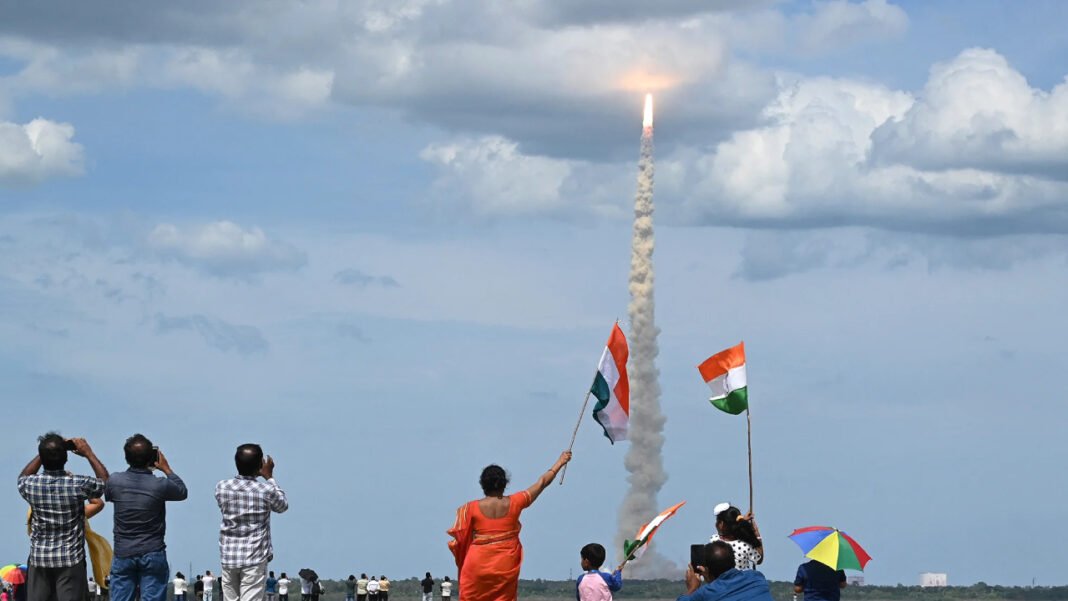By: Dipak Kurmi
During the moonlit nights from now until the final days of August, an air of curiosity fills the hearts of Indians, compelling them to lift their eyes to the heavens. In playful anticipation, they scan the vast expanse above, searching for a remarkable sight – a tiny spacecraft, a minuscule creation of humanity, defying the formidable distances of space as it steadfastly journeys towards our nearest celestial companion.
With a captivating start from the Satish Dhawan Space Centre in Sriharikota on a thrilling Friday afternoon, India’s third lunar mission has once again ignited the public’s imagination, much like its predecessors. The Chandrayaan-3 mission, carried by the robust Launch Vehicle Mark3 (LVM3) of the Indian Space Research Organisation (ISRO), follows in the footsteps of Chandrayaan-2, sharing several similarities. As the spacecraft gracefully enters the moon’s orbit in late August, ISRO will endeavor to achieve a successful soft landing and unleash the remarkable six-wheeled rover, rectifying the setback encountered during the Chandrayaan-2 mission in 2019 when the lander ‘Vikram’ unfortunately met with a crash on the lunar surface.
Embarking on a remarkable lunar exploration, India’s latest mission has been meticulously engineered to overcome the formidable obstacles of a robotic moon landing near the enigmatic South Pole, as revealed by S Somanath, Chairman of ISRO. Guided by a well-designed propulsion module, the intricate configuration of the lander and rover will gracefully traverse a circular polar orbit approximately 100 kilometers above the moon’s surface. Within this triumvirate of space-bound marvels lies a treasure trove of scientific payloads, each purposefully crafted to unravel the mysteries and deepen our understanding of Earth’s solitary celestial companion.
Within the intricately crafted mission, the lander carries a suite of four invaluable payloads, each offering a unique lens into the lunar landscape. ChaSTE, with its precise thermal measurement capabilities, seeks to unravel the mysteries of the polar region’s lunar regolith. RAMBHA, the Langmuir Probe, diligently observes the ever-changing near-surface plasma density, providing valuable insights over time. Meanwhile, the Instrument for Lunar Seismic Activity (ILSA) stands ready to record seismicity, unraveling the moon’s hidden geological secrets. Complementing these is the LASER Retroreflector Array (LRA), a passive experiment that unravels the enigmatic dynamics of our celestial companion. Onboard the rover, further scientific marvels await, with the LASER Induced Breakdown Spectroscope (LIBS) meticulously studying the chemical and mineralogical composition of the lunar surface, while the Alpha Particle X-ray Spectrometer (APXS) meticulously deciphers the elemental composition of the soil and rocks surrounding the landing site. Not to be forgotten, the Propulsion Module carries the Spectropolarimetry of HAbitable Planet Earth (SHAPE) payload, poised to provide us with remarkable insights into our own planet from the vantage point of lunar orbit. Together, these scientific instruments embark on an extraordinary quest to deepen our understanding of the moon and its intricate mysteries.
Should India achieve a successful moon landing in August, it will join an exclusive league of nations – only the fourth after the United States, Russia, and China – to accomplish this remarkable feat. Furthermore, the triumph of Chandrayaan-3 will serve as a resounding boost for the Indian space agency, setting the stage for its next audacious endeavor – the manned Gaganyaan mission. To ensure a secure touchdown, significant enhancements have been implemented in the lander’s design, as elucidated by Somanath during his recent visit to Thiruvananthapuram. Strengthened “legs” and enhanced capabilities to withstand greater descending velocities stand as vital safeguards. Notably, the propellant quantity has been augmented, solar panels now cover a larger expanse, and novel sensors have been incorporated, fortifying the lander’s mission readiness.
However, prior to the unfolding of these grand endeavors, lies the crucial journey of the Chandrayaan-3 spacecraft itself – a voyage spanning a staggering distance of approximately 384,000 kilometers to reach its lunar destination. The spacecraft must navigate the vast expanse of space, traversing this formidable cosmic path with precision and fortitude, as it embarks on its epic odyssey towards Earth’s closest celestial companion.
As the clock ticked towards Friday’s launch, an atmosphere of anticipation enveloped the Mission Control Centre at the Sriharikota Range. The tension that gripped the room gradually gave way to elation as the LVM3M4/Chandrayaan-3 mission gracefully soared from the second launchpad. Cheers erupted and smiles illuminated faces when confirmation arrived that the spacecraft had successfully settled into a precise orbit around our blue planet. In that exhilarating moment, a radiant Somanath, accompanied by Mission Director S. Mohan Kumar, joyfully declared, “Chandrayaan-3 has embarked on its awe-inspiring journey towards the moon. Our beloved LVM3 has flawlessly placed the Chandrayaan-3 craft into its designated orbit, marking the commencement of an extraordinary mission.”
Reflecting on the flawless launch, S. Unnikrishnan Nair, Director of the Vikram Sarabhai Space Centre, hailed it as a perfect and punctual performance. With every component of the LVM3 functioning flawlessly, the success was evident. As the days unfold, ISRO’s focus will shift towards crucial orbit raising maneuvers, leading up to the eagerly anticipated translunar injection. This pivotal maneuver, scheduled around July 31 to August 1, will set the spacecraft on a trajectory to rendezvous with the moon in late August. The awe-inspiring sight of the LVM3 gracefully ascending into the heavens, witnessed by many on television, serves as a reminder of the remarkable transformation of India’s space program. Once deemed distant aspirations, missions to the moon and Mars have now become pivotal pursuits for the visionary minds that shaped India’s space program. Driven by the imperative to address national priorities and concerns, Vikram Sarabhai famously articulated the conviction that advanced technologies must be harnessed to tackle the real challenges faced by society, firmly positioning India as a formidable player on the global stage.
As the Indian space program evolved, it seemed only natural for ISRO to cast its gaze towards the moon and beyond, breathing life into the visionary mission conceived by Dr. Sarabhai. Along the trajectory of progress, earnest discussions took center stage. ISRO has highlighted that the notion of an “Indian scientific mission to the Moon” was initially sparked during a meeting of the Indian Academy of Sciences in 1999, followed by further deliberations within the Astronautical Society of India in 2000. The January-March 2000 edition of Space India, a publication by ISRO, featured an intriguing article titled ‘Asking for the Moon!’ The article commenced with the captivating words, “Discussions have commenced under the auspices of the Indian Academy of Sciences and Astronautical Society of India, providing scientists, engineers, and mission planners a platform to interact and explore the feasibility of embarking on a lunar mission.”
In the wake of these discussions, ISRO swiftly established a dedicated team to delve further into the prospects of a lunar mission. Under the leadership of George Joseph, a distinguished former director of the Space Applications Centre in Ahmedabad, the National Lunar Mission Study Task Force came into existence. During this formative stage, the mission itself bore the name ‘Somayana-1’, embodying the initial vision for India’s ambitious journey to the moon.
During his Independence Day address on August 15, 2003, the esteemed former Prime Minister Atal Bihari Vajpayee unveiled India’s ambitious plans for the Chandrayaan-1 mission. The culmination of these aspirations took flight on October 22, 2008, as the spacecraft embarked on its momentous journey, propelled by the Polar Satellite Launch Vehicle C11 (PSLV-C11). Laden with 11 remarkable scientific instruments, Chandrayaan-1 etched its name in history, capturing global attention for its groundbreaking discovery of water molecules on the lunar surface. This monumental achievement marked a significant milestone in India’s space exploraion journey.
Following an 11-year interlude, India anxiously awaited another opportunity for a close encounter with the moon. However, during this hiatus, the nation achieved a remarkable milestone with the triumphant launch of the Mars Orbiter Mission, affectionately known as ‘Mangalyaan,’ in 2014. Amidst great acclaim, the Chandrayaan-2 mission commenced on July 22, 2019, taking flight from Sriharikota on the dependable GSLV MkIII-M1 rocket. This remarkable spacecraft, carrying the Vikram lander and the ‘Pragyan’ rover, gracefully entered lunar orbit a month later on August 20. While initial descent progress appeared promising, communication between the Vikram lander and Earth’s ground stations was tragically lost at an altitude of 2.1 kilometers.
With the commencement of Chandrayaan-3’s momentous journey to the moon, ISRO scientists now face a paramount challenge – to meticulously ensure that every intricate component functions flawlessly, leaving no room for error. The collective efforts are focused on surpassing past setbacks and orchestrating a successful lunar landing, as the nation of India endeavors to etch its mark upon the lunar surface. (The writer is a journalist and commentator based in Guwahati, can be reached atdipaknewslive@gmail.com)












